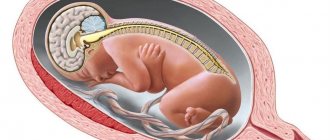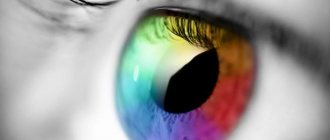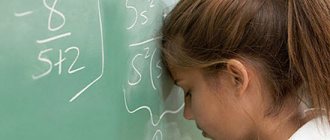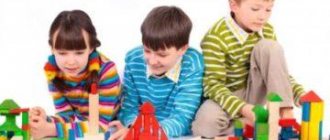What is this in psychology?
The first stage of mental development is visual and effective thinking (from 0 to 3 years). This form of thinking is characterized by the relationship between the physical properties of an object and the possibilities of its use; it is also called “manual intelligence”.
Which hemisphere is responsible for it?
Important. The human brain is a complex system responsible for all body processes.
In the 1990s, V. Rotenberg hypothesized that the left hemisphere is responsible for logical thinking. It is narrowly focused, as it connects the object with the problem being solved. While the right one covers more expanded possibilities, correlating information from different sources, forming images. Both hemispheres work in conjunction.
Features of the development of visual and effective thinking in children
In the process of learning about the environment, children carry out many manipulations with surrounding objects:
- throw;
- break;
- are sorted out.
Parents often scold their children, thinking that they are acting up, but this is not the case. All this activity is precisely the result of a child’s visual and effective thinking. This is a necessary step for the further development of intelligence.
Theoretical imaginative thinking
What is the peculiarity of imaginative thinking? This type is different in that the “material” for thinking is not a visual object or concept, but an image. It comes from memory or is recreated by imagination. People of creative professions, in particular writers and screenwriters, most often resort to imaginative thinking. Psychologist N.I. Kozlov called this type scenario thinking.
People with strong imaginative thinking are said to have developed intuition. In fact, when they see a situation, they recreate possible turns of events from experience. Using logic and imagination, they can predict the development of even a situation unfamiliar to themselves.
Imaginative thinking: Unsplash
According to other classifications, in addition to the above types, there are also creative, analytical, intuitive thinking, pre-logical (the ability to compose the simplest logical chains), alternative (the ability to build several possible scenarios for the development of events and choose the best one), critical, strategic thinking, etc.
A person uses all types of thinking, but the greatest development is achieved by the one required by the type of activity. Find out what kind of thinking you do best, and it will likely become the basis of your profession.
Original article: https://www.nur.kz/family/school/1791961-vidy-myslenia-i-ih-harakteristika/
Diagnostic and study methods
Characteristics of levels, starting with objective perception
A child receives his first impressions of the world around him after birth. Gradually, his worldview is replenished with new sensations and images (read more about what imaginative thinking is, why it is needed, and from this article you will learn why you need to improve this way of thinking in adults and children).
The thinking of a little person consists of the concept of the properties of an object, comparing data, searching for differences, and obtaining new sensations. His parents help him in this, sharing their knowledge, teaching and educating him. With the ability to move independently, the baby expands his capabilities in exploring the world, adding new images to it. The child analyzes and systematizes the entire stock of information, creating his own picture of the world.
Closer to one year, the baby, through practical actions, trial and error, receives new information and learns the properties of objects. From one to two years - combines and operates with objects. At the same time:
- learns to understand speech;
- develops memory;
- auditory and visual perception.
By 3 years old the baby:
- significantly increases memory capacity;
- improves speech;
- learns to solve practical problems using the information received.
Manifestation of pathological variants and their correction
Attention. In children with mental disabilities, sensorimotor thinking is characterized by a lag. They do not have the skill of generalizing their experience in actions with everyday objects. Without the help of an adult, they are not able to analyze and discard erroneous options, thereby not being able to achieve their goal.
“Special” children do not have the need to connect action with speech, which indicates that their manipulations are not conscious. This is a feature of the development of oligophrenics and autists. Timely correction of these pathologies gives good results.
In adults, serious violations can manifest themselves in a rollback to the visual-effective period of thinking. Characterized by obsessive repetitive movements and manipulation of objects. It appears in schizophrenics and catatonics.
Examples of practical diagnostic methods: how is it possible using cubes and other methods?
With the help of diagnostics, specialists are able to determine the integrity of a child’s intelligence. Some techniques are:
- "Pyramid addition" . The inspector shows the child the pyramid and asks him to disassemble it, then assemble it, taking into account the size of the rings. If the subject does not understand it, the experimenter shows how to do it and asks the child to repeat his actions. If the child does something wrong, they do not stop him; they explain his mistakes and ask him to redo it. Instead of a pyramid, you can build towers from cubes or objects from a constructor.
- Seguin board" is a board with recesses for different figures. The difficulty depends on the age of the subject. Older children are offered boards where the inserts consist of several parts. The psychologist shows the child the assembled board, then pours out the contents and offers to assemble it.
- “Get the cart” - a cart with a ring through which a rope is threaded is placed on the table. The child’s task is to pull the cart towards him by folding both ends of the rope. Adults don't show you how to do things right. If the rope slips, it is corrected out of sight of the person being tested. Suitable for children aged 4-5 years.
There are quite a few similar research methods. Each psychologist himself selects the closest and most informative diagnostic method to him.
1.2. Physiological basis of thinking
Like all mental processes, thinking is an activity of the brain.
The physiological basis of thinking is temporary nerve connections (conditioned reflexes), which are formed in the cerebral cortex. These conditioned reflexes arise under the influence of second signals (words, thoughts), reflecting reality, but they necessarily arise on the basis of the first signal system (sensations, perceptions, ideas).
I.P. Pavlov wrote that “kinesthetic stimuli coming to the cortex from the speech organs are second signals, signals of signals. They represent an abstraction from reality and allow for generalization, which constitutes our superfluous, specifically human, higher thinking...”
That is, the physiological basis of thinking is brain processes at a higher level than those that serve as the basis for more elementary mental processes, such as sensation. However, at present there is no consensus on the significance and order of interaction of all physiological structures that support the thinking process. It is undeniable that the frontal lobes of the brain play a significant role in mental activity as one of the options for purposeful activity. In addition, there is no doubt about the importance of those areas of the cerebral cortex that provide gnostic (cognitive) functions of thinking. There is no doubt that the speech centers of the cerebral cortex are also involved in ensuring the thought process.
Unlike sensations, perceptions and memory, second-signal connections are more complex systems that reflect various relationships between objects and phenomena.
In thinking processes, both signaling systems are closely related to each other. The second signaling system allows for unlimited orientation in the surrounding world; through it, “the highest human adaptation - science” is created.
But the second signaling system relies on the first. If words are deprived of a certain real meaning for a person, if a person cannot correlate them with some specific objects and phenomena, then such words cease to be signals of reality. Thinking proceeds normally only with the participation of both signaling systems, but the leading role remains with the second signaling system, since the word is a signal richer in content and is associated with the processes of abstraction and generalization.
The complexity of studying the physiological foundations of thinking is explained by the fact that in practice thinking as a separate mental process does not exist. Thinking is present in all other cognitive mental processes, including perception, attention, imagination, memory, and speech. All higher forms of these processes, to a certain extent, depending on the level of their development, are associated with thinking.
Thus, thinking is a complex analytical and synthetic activity carried out by the joint work of both signaling systems. Moreover, since thinking is a reflection of reality generalized using a word, the second signaling system plays a leading role in this activity. Constant and close interaction with the first signaling system determines the inextricable connection of the generalized reflection of reality, which is thinking, with sensory knowledge of the objective world through sensations, perceptions, ideas.
Why is it important to develop thinking?
Visual and effective thinking is the starting point for the formation of other forms of intelligence. It is necessary for the independent existence of the individual. You can't do without it in everyday life.
What is the obstacle?
Important. The formation of visual and effective thinking is a natural process for a healthy child. Due to their natural inquisitiveness and temperament, some children go through this path themselves, while others need parent guides who will help, explain, and show.
We talked more about the features of visual-effective thinking in children here.
It is important to provide the opportunity to study the world around us and the processes occurring in it. But there are “special” children with intellectual disabilities who need to be worked with through repeated repetitions of certain actions.
Exercises that help you gain skills
The curiosity of children is a good incentive for the development of this thinking. The task of parents is not to block cognitive activity , while monitoring safety.
Choose multifunctional toys, various types of construction sets, and materials for children's creativity. Give your child the opportunity to participate in all household chores, using household appliances and other “adult things” under close supervision, explain, show.
Play role-playing games. Ask your child:
- feed the doll;
- ride the bear;
- give the bunny a bath.
Older children can draw shapes on a checkered piece of paper and invite them to repeat them.
As for adults, this type of thought process can be trained with the help of chess, puzzles, and modeling. You can also perform special exercises, for example:
- Take a box of matches and make shapes from them.
- Master origami.
- Draw various triangles, circles, and rhombuses on a piece of paper. Then, using scissors, cut each shape into a square.
Developmental tasks for preschoolers on logical thinking
If in early preschool age visual and figurative thinking is dominant, then older children on the threshold of schooling should rely on logic in their conclusions. It
is also important to justify all your decisions verbally. Therefore, this type of thinking has another name - verbal
Effective techniques that develop verbal logical thinking in older preschoolers include didactic games and exercises.
Association games
Verbal games for building an associative series are perceived with interest by preschoolers, as they are based on images. Children imagine what is behind the proposed concept and come up with words related to this concept.
1.Who will praise best? Children are asked to come up with as many characteristics as possible for one object. You can add a competitive nature to this game.
2. Identify the owner. Children are given one or two striking signs, on the basis of which they determine a holistic image.
- tail and ears
- pen
- spines
- sheet
- lid
3.Free associations. Instructions: “What image or sign do you remember when you hear this word?” Several people can take part in the game. The first names any word, the second names its association with it, the third names the quality or concept associated with the previous word. Sometimes you can clarify why exactly this association arose in a preschooler.
Logical reasoning exercises
1.Complete tasks using visual material. Children are offered pictures with images where they have to identify an extra object, pick up a missing one, or insert a missing figure into its place.
The preschooler not only finds a solution, but also explains his choice and verbalizes his reasoning.
2. Tricky lotto. Prepare two identical sets of pictures. Children play in pairs, each participant receives their own set.
One of the participants chooses one picture at his discretion and, without showing it, describes the image, highlighting the main features. The second participant guesses and then offers his description of another picture.
3. Guess it! Participation of four or more children is desirable. Preschoolers form two subgroups. One of them agrees on what object to wish for. Participants in the second subgroup, in order to guess the object, ask questions that can only be answered in monosyllables - “yes” or “no.”
The task is not only to guess, but also to be able to identify important signs. Having received the answer, the subgroups change roles.
Games for the development of conceptual apparatus
1. Help out the alien. Children really love this game, in which it is assumed that they have met an inhabitant of another planet who knows nothing about our world. Typically, one child plays the role of an alien and asks questions:
- What is this?
- What is this item for?
- How to use it?
One or two preschoolers answer questions from an inquisitive guest. The game well develops verbal logical thinking, as well as coherent speech.
2. Does this happen or not? Instructions: “Make a true and false judgment using the given words.” Prepare a few pairs of words for the game.
For example, a tree - roots. True proposition: “Every tree has roots.” False: “leaves grow on the roots of the tree.”
3. Because... Instructions: “Come up with at least three explanations for the same event (phenomenon, fact).” Example: The flowers bloomed because...
- …spring has come
- ...they were watered on time
- ...even the flowers wanted to please Masha
Such game exercises develop mental operations, the ability to establish cause-and-effect relationships, and the ability to formulate judgments and inferences.











